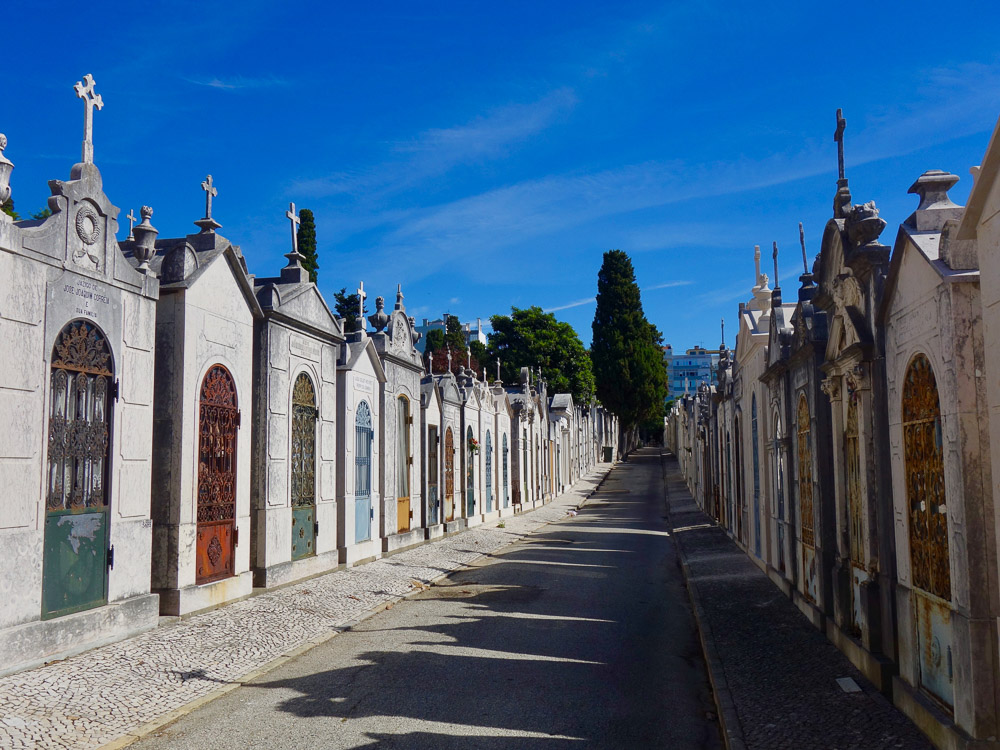Prazeres Cemetery in Lisbon is a necropolis with over 7,000 funerary monuments, some of them belonging to significant Portuguese figures, such as artists, writers and politicians. Today, I’ll tell you why you should visit it!
As someone who has spent considerable time traveling, I’ve learned that visiting a city’s cemetery is an unusual but fascinating way of getting to know its history. And Prazeres Cemetery in Lisbon is a great example of that!
Located in the western part of the city, this cemetery was established in 1833 due to a cholera epidemic. Today, Prazeres isn’t only a burial ground; it also serves as an open-air museum with amazing examples of funerary art and tombs of famous Portuguese figures.
I know this may not be everyone’s cup of tea, but if you’re interested in visiting what is known as one of the most beautiful cemeteries in Europe, then this post is for you! Join me to find out all the info you need to know before heading to Prazeres Cemetery.
Prazeres Cemetery – In a nutshell
- Highlights: chapel of Nossa Senhora dos Prazeres, tombs with glass front doors, collection of cypresses, Dukes of Palmela Mausoleum, Valle Flor Mausoleum
- Opening hours: daily, 9am to 5pm (or until 6pm from May to September).
- Best time to visit: morning or early afternoon
- Recommended duration of visit: 1h – 2h
- Address: Praça São João Bosco 568, 1350-295
- Nearest station: Campo do Ourique
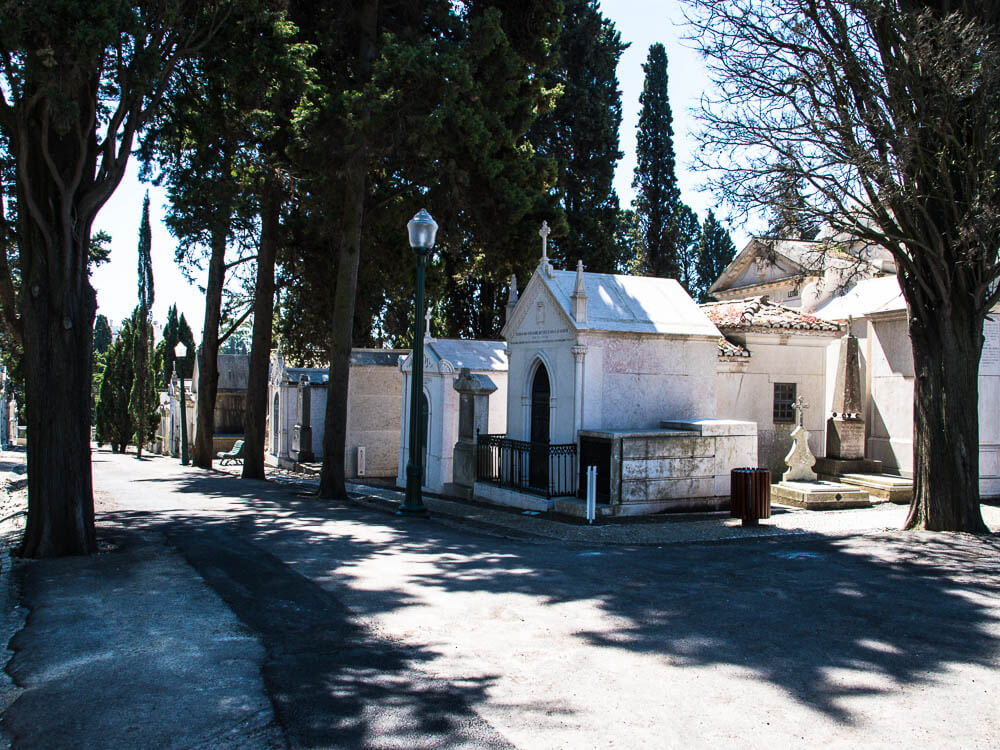
Index
- Reasons to visit
- History
- Architecture
- Famous graves
- How to plan your visit?
- Opening times and best time to visit
- How to get there?
- Attractions nearby
- Where to stay?
- Guide to respectful practices
1. Reasons to Visit Prazeres Cemetery

Let me tell you why Prazeres Cemetery, or Cemitério dos Prazeres in Portuguese, should be on your list of to-do things in Lisbon.
First of all, it isn’t only a place for remembering those who passed away. It’s also a site rich in Portuguese history. After all, this is a 19th century cemetery that serves as the final resting place for many historical figures (more on that later!), and leads visitors to a deeper understanding of the past.
The cemetery also illustrates the fascinating evolution of architecture in the context of a burial ground. The mausoleums, statues and tombstones showcase a mixture of styles that were popular in different eras, such as Gothic, Neoclassical and Manueline.
Besides that, the Prazeres Cemetery offers a quiet and beautiful space away from the city’s activity, and is filled with trees and well-kept gardens that provide a great spot for walks and reflection.
And, if those aren’t reasons enough, the cemetery is also located on one of Lisbon’s highest hills, and provides amazing views over the city toward the Tagus River and the 25th of April Bridge. Safe to say it’s worth at least a short visit, right?
2. History

Prazeres Cemetery, or Cemitério dos Prazeres, came into existence during the cholera outbreak of 1833. Before this time, burials took place in churchyards, but, with the increasing health and safety concerns, there was a clear need for a separate burial ground.
Though its name may be unexpected, as “Prazeres” means “pleasures”, there’s a simple explanation for that. The cemetery was built on the same site as a 16th century estate named Prazeres, and ended up being named after it as a way to carry on its historical importance.
Lisbon’s main cemetery is noted for its many private above-ground mausoleums that look like small houses. This gives the cemetery a distinct urban feel that is greatly enhanced by the fact that its lanes were designed to resemble the streets of a city.
In recent years, there have been lots of efforts into maintaining Prazeres Cemetery, with restoration work being performed in sculptures and mausoleums, as well as infrastructure improvements.
Besides being a historical site, Prazeres Cemetery actually still functions as a burial place for Lisbon’s population, even after almost 200 years of being built. If that doesn’t prove just how important it is to the city, I don’t know what will!
3. Architecture
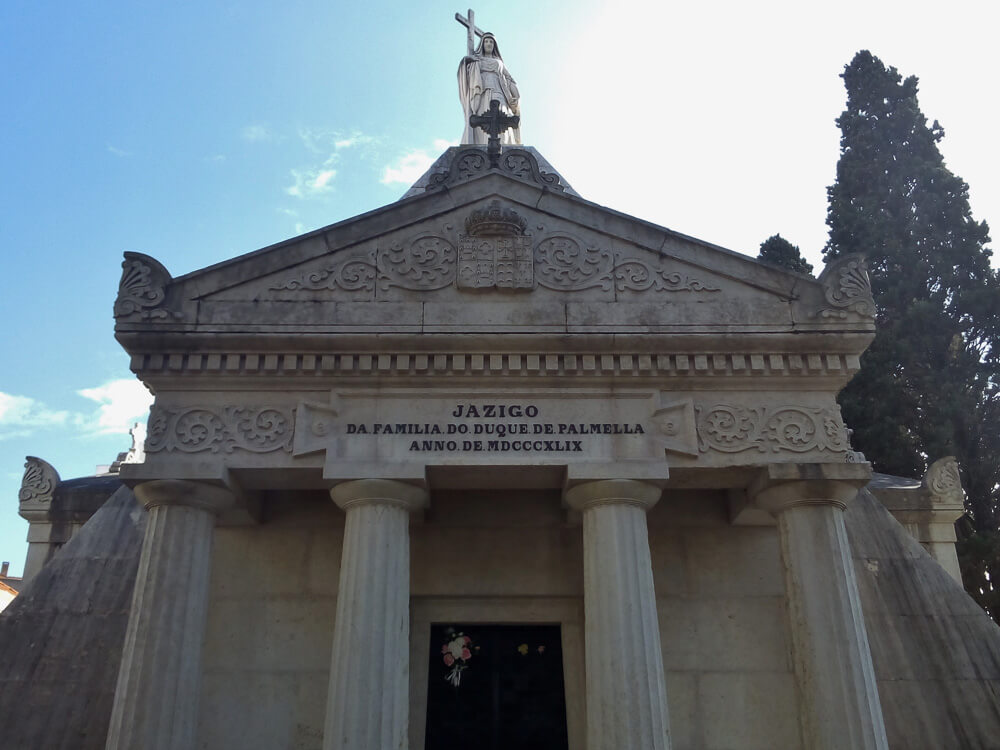
There are some very significant architectural works displayed at Prazeres Cemetery, since some of the city’s most notable families buried there hired architects and sculptors to design unique tombs to reflect their lives and histories.
There is a great range of architectural styles present in the cemetery, such as neoclassical, romantic, art nouveau and art deco. The memorials were carefully designed with detailed sculptures and stained glass windows, and many crypts have glass doors that allow visitors to see coffins, small altars and photos of the deceased.
One of the most famous buildings is the Mausoleum of the Dukes of Palmela, which holds up to 200 people and is considered one of Europe’s largest funerary monuments. Easily recognized by its large pyramid-shaped structure inspired by Solomon’s Temple, it was built in the 1840s for Pedro de Sousa Holstein, Portugal’s first modern prime minister.
Another well-known monument is the Carvalho Monteiro Mausoleum, where the owner of Quinta da Regaleira in Sintra is buried. The tomb was designed by architect Luigi Manini, mixing Romantic and neo-Manueline styles with Italian marble sculpted with symbolic images.
Other notable sites include the tombs of Marquis of Vale Flor, the former owner of the palace where the Hotel Pestana Palace now operates. Additionally, Chapel of Nossa Senhora dos Prazeres, a chapel from the mid-19th century, contains an old autopsy room predating modern morgues in Lisbon and items related to funeral customs.
4. Famous graves at Prazeres Cemetery
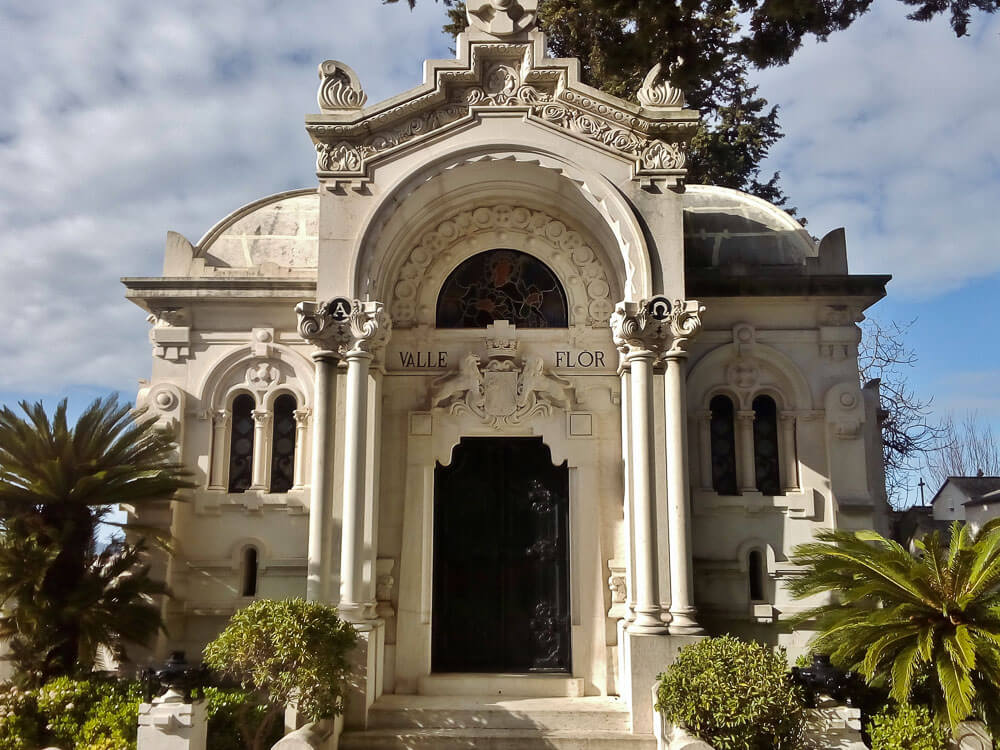
As I mentioned earlier, Prazeres Cemetery serves as a burial site for many of Portugal’s historical figures. It includes graves of individuals such as prime ministers, members of the nobility and other significant Portuguese contributors.
The first thing you need to know is that the cemetery is organized into sections based on profession. This means there are areas like the Deposits of Writers, where authors are buried together; the Field of Artists; and zones for public servants from the Public Security Police and Fire Brigade.
In the Field of Artists, you’ll find gravesites for people who have impacted Portuguese art and culture. Included here are poet Cesário Verde, actor Vasco Santana, guitarist Carlos Paredes, ceramicist Rafael Bordalo Pinheiro, and artist Almada Negreiros.
Sports figures are also present at Prazeres Cemetery with Cosme Damião, founder of FC Benfica being one notable example. He lies among other personalities including past Prime Ministers and presidents who played roles in shaping Portugal’s history.
The initial burial sites of Amália Rodrigues, the Fado singer, and Fernando Pessoa, the poet, were also at Prazeres Cemetery. However, they were relocated to the National Pantheon and the Jerónimos Monastery respectively.
5. How to plan your visit?
Entrance to Prazeres Cemetery is free, so you don’t need to worry about fitting it in your travel budget. When you’re there, you can choose between a guided tour or self-guided audio tour, both of which offer insight into the history and architectural details.
While the guides share knowledge that adds context to your visit, the audio tours allow you to explore at your own pace.
You’ll also notice that the cemetery has several paths laid out for exploration. Symbols at the graves indicate the possible routes through the grounds, each highlighting different aspects, individuals and artistic elements.
Planning your visit ahead helps you fully engage with what the cemetery reveals about Lisbon’s past and ensures you leave with a deeper understanding of its place within the city’s story.
6. Opening times and best time to visit
The cemetery is open to visitors every day from 9am to 5pm, which gives you plenty of time to explore all the paths and experience this peaceful environment. From May to September, the closing time extends to 6pm due to longer daylight hours.
I recommend visiting in the morning or early afternoon, as these times tend to have smaller crowds, offering a more intimate visitation. Besides, if you’re interested in photography, that’s when the light is most favorable.
It’s also a good idea to check for any local holidays or events that could alter regular opening hours before your trip.
7. How to get there?
The Prazeres Cemetery is easily accessible from different parts of the city. It’s located at the final stop of Tram 28 (yes, the most iconic tram in Lisbon!), which offers a direct link to the cemetery while allowing you to experience this famous attraction.
But if Tram 28 is too busy and you’d rather have a more peaceful journey, you can also take Tram 25 or bus line 709, both of which run frequently and stop near the cemetery.
8. Attractions nearby
Just a short walk from the cemetery, you’ll find Campo de Ourique Market, which offers fresh produce, local goods, and various food stalls that represent Lisbon’s culinary scene.
Also nearby is Casa Fernando Pessoa, which is a must-visit for those interested in literature. It was the home of one of Portugal’s notable poets and has been converted into a museum focusing on his life and literary work.
A short distance from these spots is Basílica da Estrela with its baroque façade and detailed interior, offering an interesting visit for those who appreciate religious art. The Museu Nacional de Arte Antiga should also be on the itinerary for art enthusiasts as it displays Portugal’s collection of European and Asian art over time.
Additionally, fado fans can visit Casa Museu Amália Rodrigues, which once belonged to the renowned fado singer and shares aspects of her personal history through artifacts in her well-maintained home.
9. Where to stay near Prazeres Cemetery
If you’re looking to stay close to Prazeres Cemetery, there are some great options for you to choose. Here are my main recommendations:
- Hotel da Estrela: housed in the Condes de Paraty Palace, this hotel offers modern rooms with designer furniture and views of Lisbon’s city center and the Tagus River. Available amenities include a restaurant, business center, bar, and garden for relaxation.
- Lisbon São Bento Hotel: located in central Lisbon, this hotel provides double rooms, twin rooms, and junior suites that come with air conditioning. Rooms feature free WiFi and flat-screen cable TV, some with city or river views. The hotel also offers breakfast services, a bar area, and 24-hour front desk.
- Jardim da Lapa by Shiadu: this 3-star hotel has air-conditioned rooms with free WiFi access. It boasts an outdoor pool for swimming on warm days, gardens for walking, snack bars, and daily breakfast buffet options including continental or vegetarian choices.
10. Guide to respectful practices
When visiting remembrance sites like Prazeres Cemetery, it’s very important to be respectful. Remember that every grave belongs to someone’s loved one, so it’s essential that you keep the environment suitable for reflection and preserve the solemn atmosphere.
A key guideline is to avoid walking on gravestones, as they represent individual lives and are memorials for the deceased and their families. You also shouldn’t sit or lean on headstones, as they can be delicate due to age, and mistreating them could lead to deterioration.
Besides that, never ever remove objects from tombstones. Such items are left as a sign of honor and have emotional importance, and taking them away interferes with this expression of memory.
Finally, don’t leave litter behind. By keeping these areas clean, you show consideration for others present and the legacy of those who have passed away.
Prazeres Cemetery is much more than a resting place
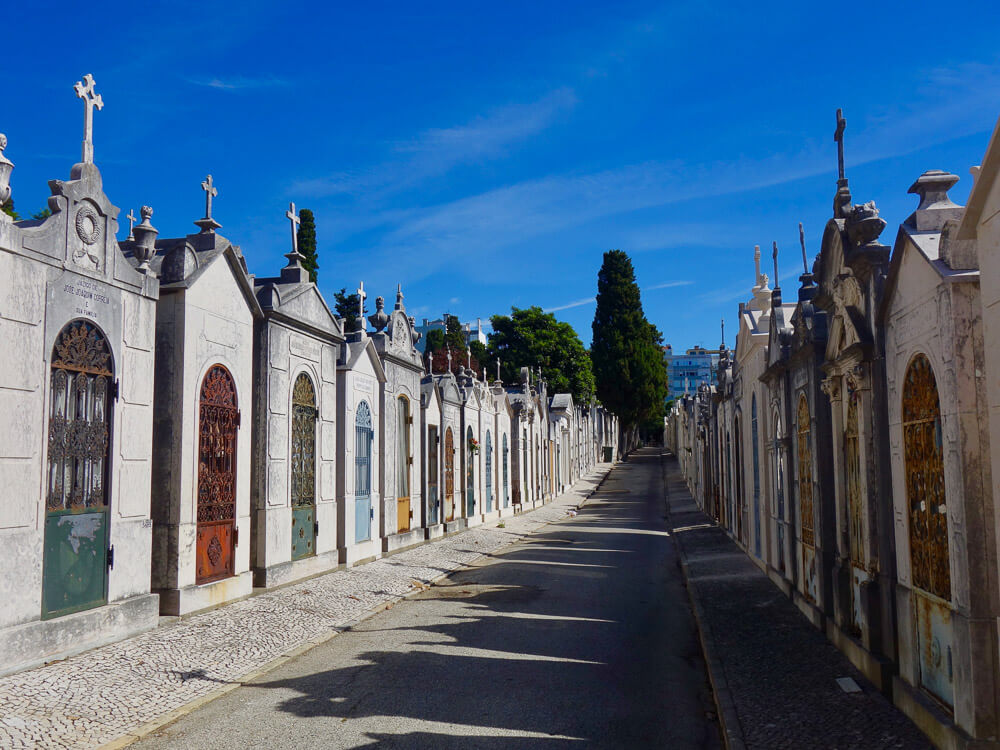
Prazeres Cemetery in Lisbon is one of the largest cemeteries in the city, a peaceful and beautiful resting place that also functions as an open-air museum. Each tomb and sculpture offers a glimpse into the lives of those who once walked through Lisbon, helping us understand both personal stories and wider historical context.
Walking through this cemetery is a unique experience that takes you away from the noise of the city and invites you to reflect on the various lives remembered there. Whether you’re interested in art, history or simply want a peaceful moment, I definitely think it’s worth visiting Prazeres Cemetery at least once!

